Since childhood, observing the sky has always been a passion, almost a must. The arrival of the night was a magical moment for me, while the dawn was always a bit sad. You know, life runs fast during the day, while at night everything seems more muffled, everything is quieter.
And the stars come.
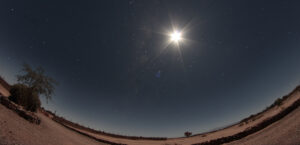
Over the years, as well as having a thousand more commitments and a thousand more complex problems than a child's free mind, the sky has also changed. In the seventies, stargazing from the city was still possible, it was still fascinating. You could see stars up to the 5th and even in some cases the 6th magnitude and very few lights dazzled the eyes with their annoying white bulb.
Today this is no longer the case.
Very few places in the world are devoid of what is now known as light pollution, that is the influence of artificial lights on the vision of the night sky: it is caused by the reflection of lights on the lower layers of our atmosphere, which obviously is "colored" with whitish halos, of a yellowish or orange wadding depending on the type of lighting used in the city.
In Italy the situation is quite dramatic, especially in the North it is impossible to find a dark place to observe the sky. Only if we go into the mountains of the Northeast, almost towards the border with Austria, do we find some peace in the dark.
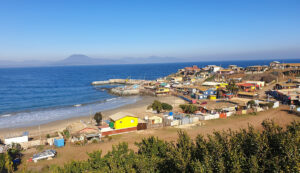
However, there is a place on earth that has no rivals for the darkness and sharpness of the sky: Chile. The long state that crosses almost all of South America, along the Pacific coast, is a world rich in wild nature and, above all, in the center-north, it opens into a desert area unique in the world: the Atacama desert.
It is precisely for this reason that in July 2019 I decided to take the trip that all astronomers in the world dream of: a month in the Atacama desert, alone, but in the company of the most perfect starry skies in the world. It is not an easy journey, but neither impossible, the important thing is to plan everything in detail, or at least I really like doing that.
In fact, Chile, in addition to having perfect skies from an astronomical point of view (and I will soon explain why) is also home to the largest telescopes in the world which were built, precisely for the reasons mentioned above, on the peaks of the most high mountains, immersed in the dry desert air.
The best areas to look at the sky are those at high altitudes, above 2000 meters, where the densest and most humid layers of the atmosphere are now outdated. But as we know, clouds are a big problem for the astronomer. However, Chile, and especially the Atacama desert area, has a unique peculiarity: it is "enclosed" between two mountain ranges, the Andes mountain range, towards the interior and the Costa mountain range near the Pacific. This causes the cloud formations coming from the Pacific to condense (because the air cools on the ocean due to the Humboldt current) on the ocean, and on the other side the presence to the east of the Andes chain intercepts the moisture from the Amazon basin, thus creating a perennial high pressure field.
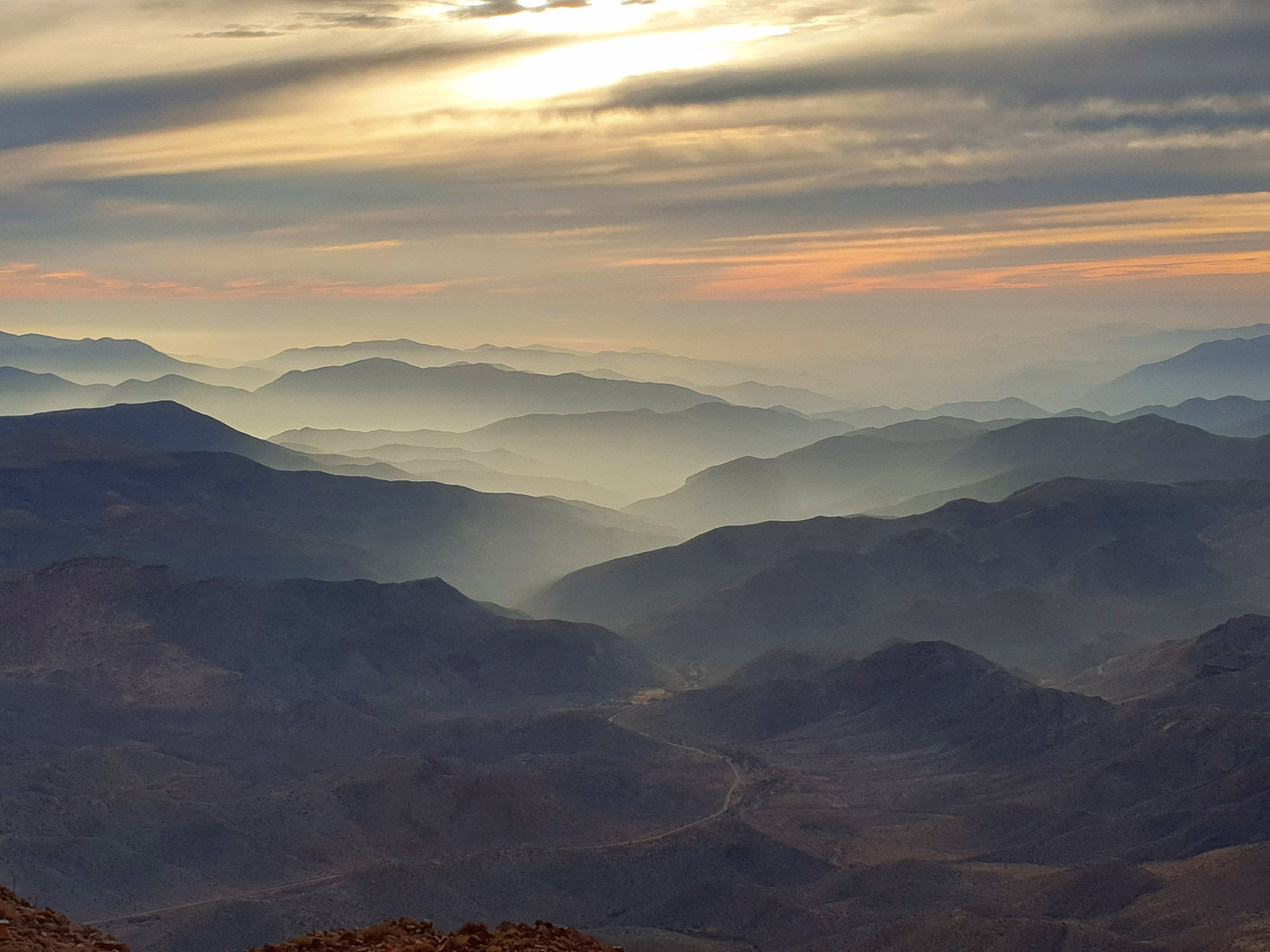
There are areas in the Atacama region where it hasn't rained for over 400 years!
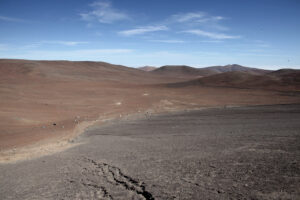
Many microbial and bacterial life forms have also disappeared: and it is for this reason that NASA has chosen some places in this desert for experiments related to Martian travel, on a land that, due to its shapes, characteristics and drought, is very close to those of the red planet.
So: clear skies in some areas for over 320 days a year, humidity that drops to 10-15% and very high mountains.
What more do you want?
Well, something else is needed, that the man doesn't ruin everything!
And the Chileans did an excellent job in this regard. There are very strict laws on light pollution (which are respected) and in the more properly "astronomical" areas of the desert (where large telescopes also reside) even the routes of airplanes are moved to the Pacific, so as not to fly over very dark areas of the desert.
I assure you that sometimes this darkness is scary: I have repeatedly found myself immersed in such total darkness that I couldn't perceive any source of light for miles around me, on the desert plain. But, on a moonless night, even the stars cast a little shadow. Yes, the Milky Way, our galaxy, that milky band that in the Chilean winter (July is the middle of winter for them) comes to cross the whole sky with the galactic center right at the Zenith above our head, projects so much light that we can note a faded shadow on the sandy ground.
For the experts, I have achieved a Sky Quality Meter (SQM) brightness of over 22 magnitudes per arcsecond squared. Crazy.
The optimal combination for planning this trip was also the presence of a total solar eclipse near La Serena, a city in central Chile, on July 2, 2019. What better time to admire the Black Sun and enjoy the most beautiful starry nights in the planet?
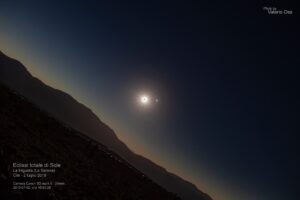
The journey to Santiago is long, over 20 hours of flight including the stopover in Madrid. A rental car was waiting for me in the Chilean capital that accompanied me for about 3800 km of travel throughout the state: in fact, Chile is a very long country and if you want to see the most beautiful parts you just have to rent a car: buses are also used (I traveled almost 1000 km with those, too) but a car, especially in desert areas and to be able to move freely during the night, is essential.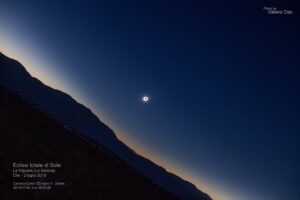
The appointment with the eclipse did not disappoint me: a perfect sky near La Higuera, north of La Serena and the spectacle was exciting, like any self-respecting total eclipse.
Palpable emotion even among the many people who crowded the whole range, with a duration of about 2 and a half minutes, enough for some nice photos but, as always, too few. The moment the moon's shadow comes out always leaves a bit of bitterness, knowing that for who knows how long you won't feel such a strong emotion in front of nature's greatest spectacle. If you want to know more about eclipses, read my blog post “Eclipse Hunting”.
The astronomical path that I had planned had begun successfully. Now I could begin to observe the most beautiful night sky on the planet and visit the largest astronomical observatories in the world.
But I'll tell you this in the next episode.

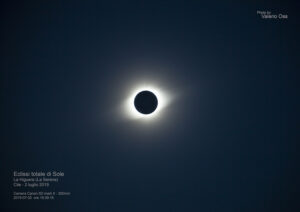
On the Video Gallery page you can see "Sunset of an eclipse", a video made from a series of photographs during the eclipse of 2 July 2019
